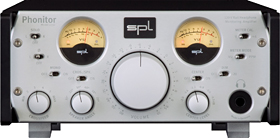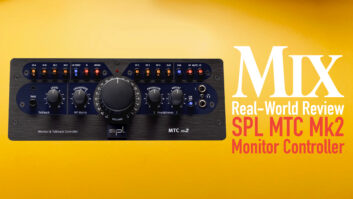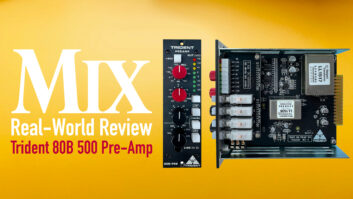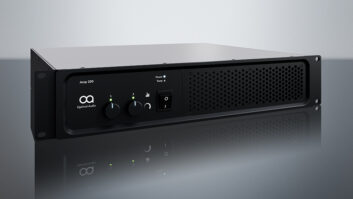
Phonitor’s Crossfeed, Speaker Angle and Center Level controls provide ways to simulate a speaker’s interaction with a room.
Mixing with headphones is usually a losing game. It produces an unrealistically wide stereo effect and makes hard-panned tracks sound louder than they are when played over loudspeakers. The result? Mixes executed using headphones don’t translate well to other systems.
SPL’s Phonitor attempts to correct headphone monitoring problems so that mixes will translate well to loudspeakers. The unit’s controls aim to re-create a loudspeaker-style soundfield while the user is listening to headphones. The system also offers a few other functions that are of great benefit during mixing and mastering.
Head Trip
More than just a pretty face with a sturdy body, Phonitor incorporates SPL’s proprietary Supra Ops 120-volt discrete op amp technology, yielding 150dB dynamic range and almost immeasurable THD.
A typical setup is to route the “control room” outs from your console or DAW monitoring station to Phonitor’s XLR inputs. Its XLR outs connect the system’s pass-through signals to your powered monitors or power amp. A large volume control adjusts the output routed to the headphone jack. A Dim switch attenuates headphone-output level by 20 dB. Backlit left/right VU meters display switch-selectable VU or PPM output levels. Another switch reduces the meters’ sensitivity by 6 dB to allow hotter input without pinning the meter needles. Other switches are provided for solo, left- or right-channel phase reverse, and to select stereo or mono monitoring
Three six-position switches — labeled Crossfeed, Speaker Angle and Center Level — adjust the soundfield to resemble speaker playback. Crossfeed adjusts the interaural level difference of left and right channels, essentially mixing a little signal from each channel into the other. Speaker Angle tweaks the interaural time differences of left/right channels to simulate monitors placed 15 to 75 degrees to the listener. As Crossfeed is increased and Speaker Angle is decreased, stereo width is decreased and the phantom center image gets louder. To compensate for this and restore balance, the Center Level control can attenuate the center image volume. Center Level has its own bypass switch, while Crossfeed and Speaker Angle can only be bypassed together.
Now Hear This
I connected Phonitor to my Yamaha 02R mixer and AKG K271 ‘phones and listened to various stereo mixes. With the Crossfeed, Speaker Angle and Center Level controls bypassed, the sound was extremely detailed and open, and the spectral balance very smooth. Headphone levels were plenty loud, even with the volume control attenuating the input 28 dB.
Increasing the Crossfeed made the sound more monophonic. Decreasing the Speaker Angle setting made the stereo image narrower but retained its stereo separation. Using these controls with the Center Level control, I could mitigate the ‘phones’ super-stereo effect and adjust the level balance of panned and center elements of the mix so it more closely resembled listening to my near-fields.
That said, the result didn’t sound like listening to my monitors in a room. Most noticeably absent from Phonitor’s reproduction was the sense of depth one gets from listening to speakers in an acoustic space. And, of course, no system can possibly divine and re-create the unique coloration my specific reference monitors — and acoustic room treatments — impart. But Phonitor did put the levels of panned and center elements into proper perspective.
Out-of-phase LF elements in a mix (such as kick drum and bass guitar) are often the cause of thin-sounding mixes. Setting the Phonitor to mono, I could check the phase of center-panned elements of my mix by reversing the phase of the left or right channel. Such a setup monitors the “difference” signal (that which is not common to both channels). As long as all stereo effects are momentarily bypassed, any mono signal that is panned to dead-center should completely disappear in this setting, which should also reveal any distortion caused by A/D or D/A converters clipping.
Phone Home
If you must mix using headphones, Phonitor should decrease any balancing level mistakes. The system’s mono, phase and solo functions make phase problems and distortion readily apparent in a mix. In fact, the unit’s pristine sound is very revealing in all setups. While the price tag is somewhat steep, anyone who mixes or masters should find Phonitor a useful addition.
Mix contributing editor Michael Cooper has written more than 300 articles about pro audio during the past 20 years.








